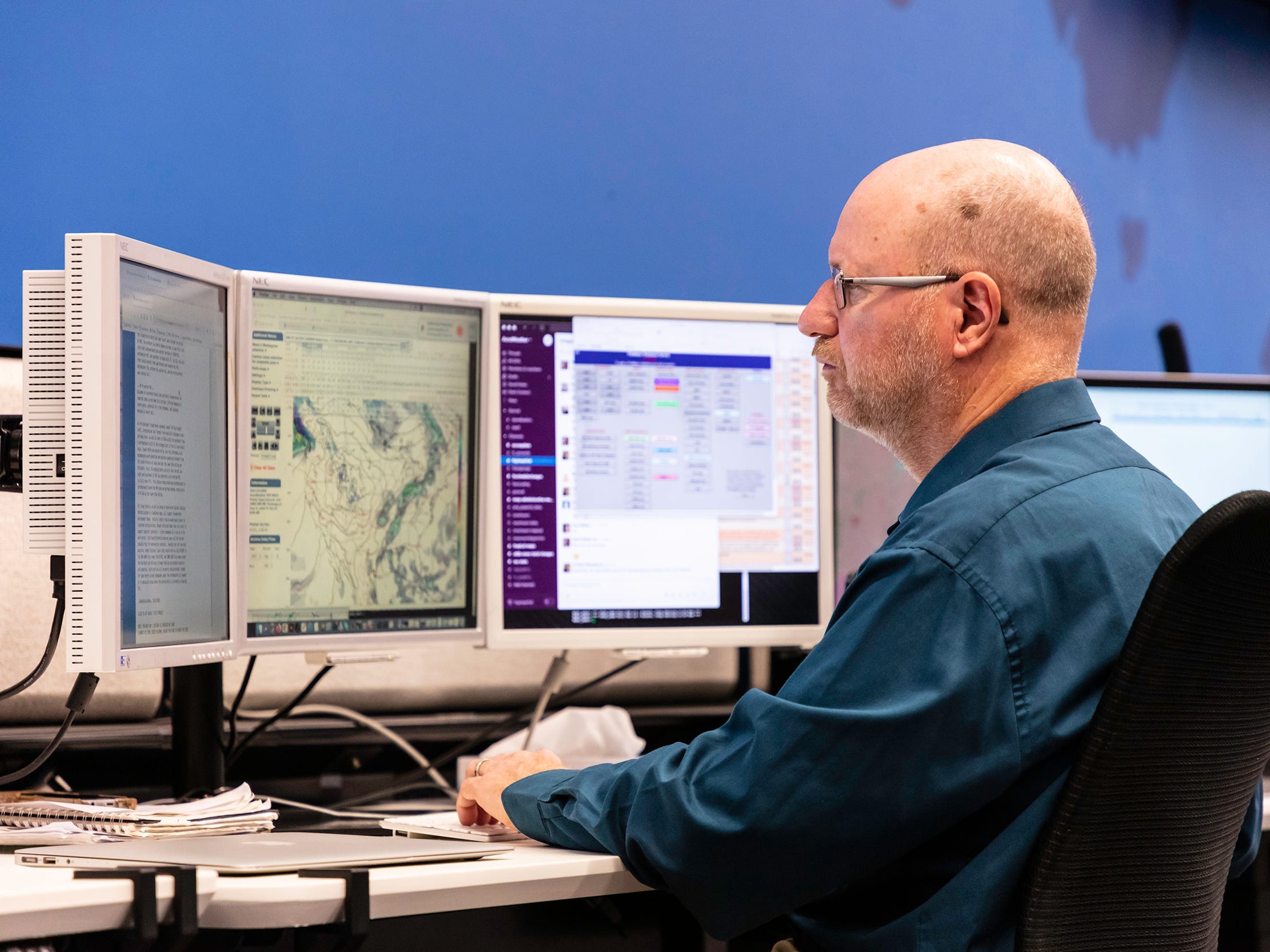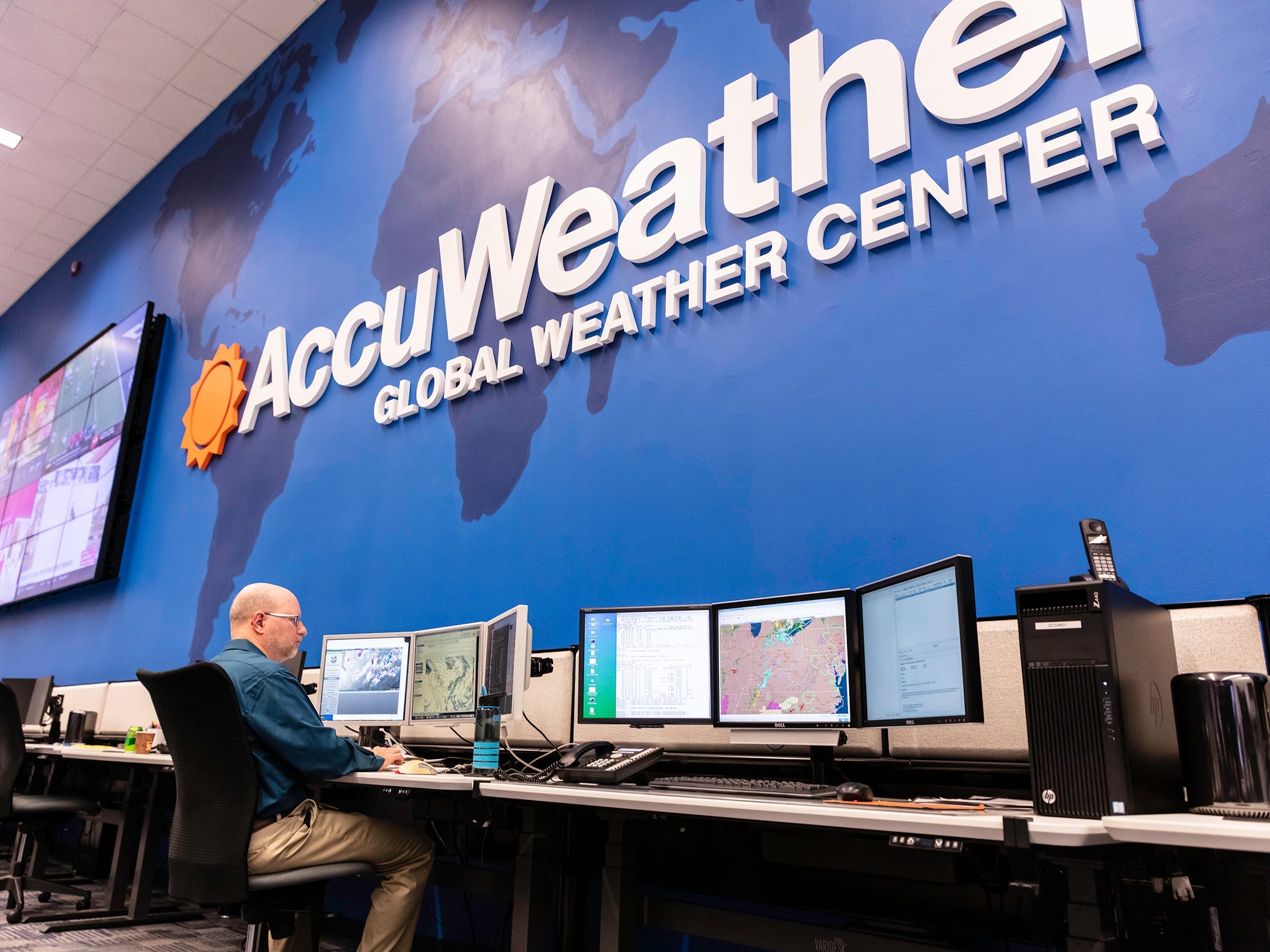
Courtesy of Brian Wimer
- Brian Wimer is a senior meteorologist and manager of snow-warning services for AccuWeather.
- For the past 40 years, he's tracked snowstorms and helped schools, businesses, and locals prepare.
- This is his story and what his job is like, as told to freelancer Robin Madell.
This as-told-to essay is based on a transcribed conversation with Brian Wimer, a senior meteorologist and manager of snow-warning services for AccuWeather based in State College, Pennsylvania, where he's worked for the past 40 years. It has been edited for length and clarity.
I attended Pennsylvania State University and graduated with a BS in meteorology. Some people in the field continue their education in graduate school but many, like me, move into a career with a bachelor's degree.
The pay within the field of meteorology varies greatly depending on the job you're in. TV meteorologists in large cities are among the highest-paying jobs in the field.
While my typical workday is around eight hours long, days leading up to a major winter storm can be 10 or 12 hours long

Courtesy of Brian Wimer
It's not unheard of to see colleagues come to work with an overnight bag.
While days forecasting big storms are the busiest and most hectic, forecasting and following these storms is exciting and is what led us to become meteorologists. An analogy would be a football team that gets amped up when they play the best team in the league - with all the challenges and energy that brings.
During a big storm, we work together to share the latest pieces of information, constantly looking for things that may be changing with the storm and discussing whether we need to adjust our forecast for any location.
We're all completely devoted to our mission of keeping people, communities, and businesses safe and protected, and these moments are legendary and seared into our memories and make for great "war stories" over the course of the years. My colleagues and I all have great respect for one another and enjoy our common bond to help people make the best weather-impacted decisions.
During the day, there's a great deal of collaboration with other forecasters in both State College, Pennsylvania - where AccuWeather was founded in 1962 and where our global headquarters remains - and Wichita, Kansas, where we have an experienced team of storm-warning meteorologists in our Extreme Weather Center, which provides forecasts to our AccuWeather for business clients.
On a typical winter day, the first thing I do is look at what areas a storm may impact

Courtesy of Brian Wimer
This is not only in the next couple of days, but also looking out six to eight days in the future.
Once we identify a storm, part of my day is to proactively send alerts and warnings to customers with details on what they can expect from the storm in their location. We send these out mostly via email, text message, and posted on a web portal for customer access.
Another part is doing telephone briefings for our business clients and media. These can be one-on-one calls or sometimes conference calls with hundreds of people, explaining details of the approaching storm and answering questions.
We partner with TV stations and provide briefings and forecasts for their on-air meteorologists and broadcasters. In many cases, the TV meteorologist prepares their own forecast but is interested in gaining insight and information from the AccuWeather team, which can often give them an edge on their competition.
We also do live radio reports on numerous radio stations across the country and perform interviews with media outlets on the impact from the storm and provide preparedness tips.
Each storm has unique aspects that we focus on predicting ahead of time
At the beginning of the day, the first thing we do is look at the current weather conditions, accessing our database of reports from around the world, including data from surface stations, upper-air balloons, satellite images, and radar. This includes temperature, moisture, wind, and where it is raining or snowing.
Then, we look at a large variety of forecast models that provide insight into what will happen over the coming hours and days. We also factor in our experience and what we recall happening in similar situations in the past. Putting this all together and discussing possibilities with other forecasters, we come up with a forecast of how a storm will behave, including how much it may strengthen (and how quickly) and what direction and speed it will move.
Another concern is high snowfall rates. Even a storm producing moderate total snow accumulation can become very problematic if there's a period of heavy snowfall. When snowfall rates reach or exceed one inch per hour, it becomes very challenging for road crews to stay ahead of the storm and keep the roads in good condition. These are the kinds of details we dig into and provide that make us valued by our clients and consumers.
We work with a variety of customers that winter storms affect differently
Among them are school districts and universities, who rely on our forecasts to decide whether to cancel or delay classes and also plan snow removal. They can call us and ask questions to get the latest update just prior to their decision.
Departments of Transportation use AccuWeather forecasts to plan their snow-removal operations, including staff scheduling. They don't want to have staff idly waiting too long prior to the start of a winter weather event. In some cases, they're required via contracts with employee unions to provide a minimum amount of advance notice if overtime is involved. Prior to making these decisions, DOTs can talk to us, ask questions, and get a sense of our confidence level in our forecast.
Private businesses, manufacturing plants, medical centers, and utilities are interested in receiving advance notice of storms that can disrupt activities, which can result in lives lost, injuries, or the loss of millions of dollars due to interrupted business operations. Retail enterprises are another type of client. They're interested in storm impacts on not only their physical locations, but also on their supply chains.
While snow can disrupt normal business activities, some customers look forward to snow, and it's good for their business. Private contractors clear snow from parking lots and rely on winter storms for income. Ski resorts are another example of a business type that relies on plenty of snow or conversely needs to be aware when they must manufacture snow in order to meet the needs of their customers.
One of the most memorable and exciting winter storms in my career was one in March 1993 known as the 'Storm of the Century'
I slept in the office, as did a few other forecasters, partly because I was working long hours but also because roads became impassable and I couldn't drive home anyway.
This was very notable for dumping over a foot of snow over a large area from northern Alabama to Quebec, Canada. It also produced damaging wind gusts and flooding along the west coast of Florida.
I recall when a radio client informed us of a listener who heard the AccuWeather forecast that a dangerous blizzard was approaching while he was in his car. He pulled over and waited at a library for the storm to pass and was so appreciative of the forecast, he contacted the radio station to let them know, and they in turn shared their gratitude with us. Those moments are so very rewarding.

